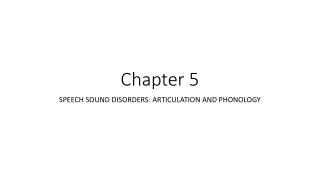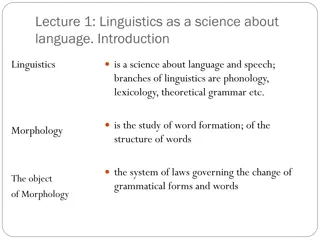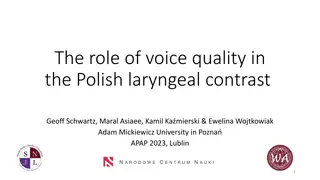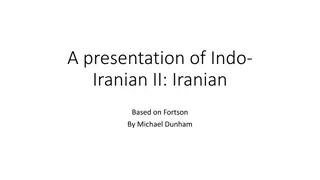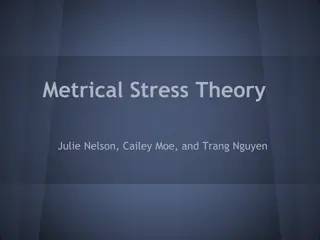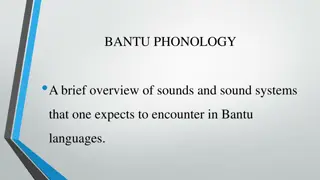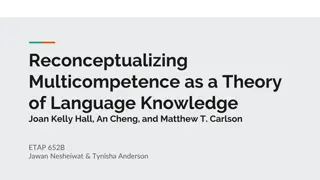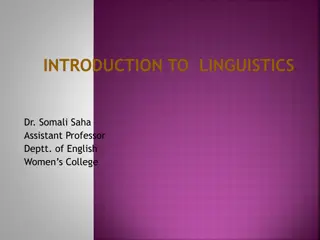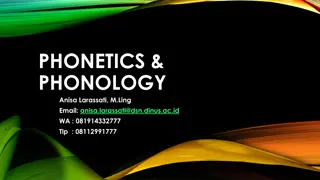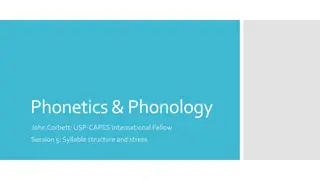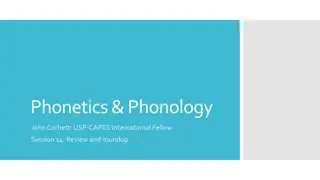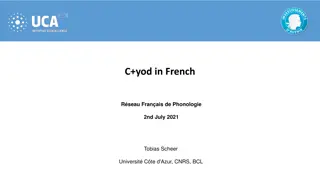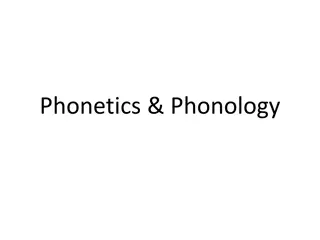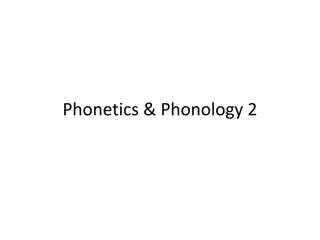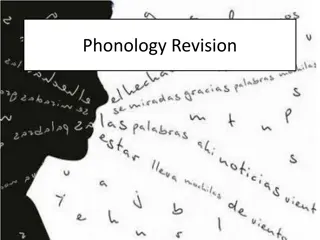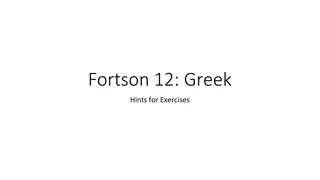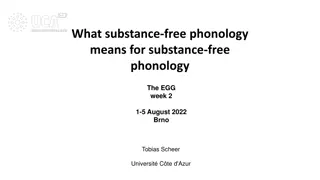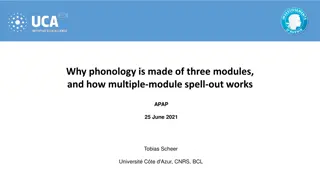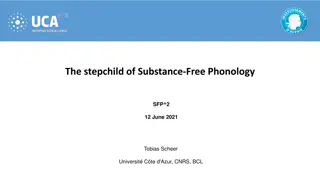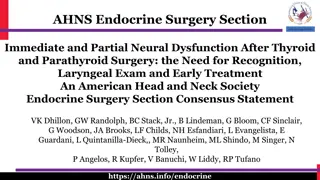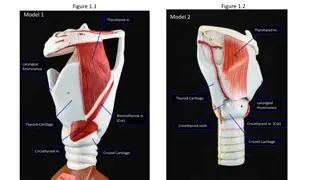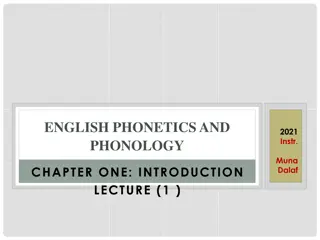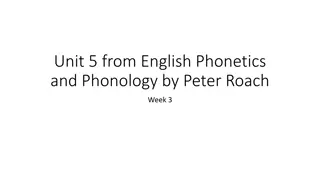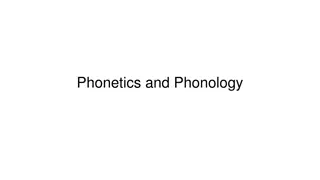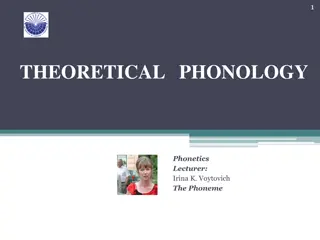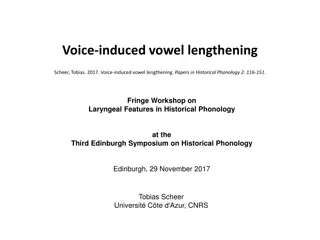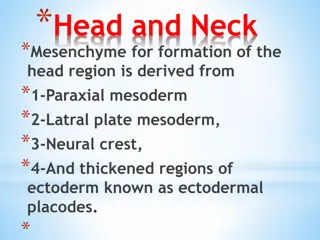Understanding Speech Sound Disorders in Children
Explore common communication disorders in children related to articulation and phonology, with insights on assessment and treatment methods. Learn about the challenges faced by individuals with speech sound disorders and the importance of early intervention.
2 views • 42 slides
Insights into Theoretical English Grammar
The theoretical English grammar delves into the subject matter of grammar, including systemic conceptions, grammatical forms, categories, paradigms, and morphological means. It discusses the constituent parts of language – phonology, lexicology, and grammar. The grammatical structure covers morpho
7 views • 26 slides
Understanding Language and Linguistics
Language is a fundamental aspect of human communication, encompassing spoken and signed forms. Linguistics delves into syntax, semantics, morphology, phonology, and phonetics to analyze language structure and meaning. Phonetics explores how speech sounds are produced and perceived, shedding light on
9 views • 10 slides
Is regressive voice assimilation a mirage?
Delve into the discussion on regressive voice assimilation, challenging traditional views of laryngeal phonology. Explore the intricate phonetic cues and contrasts that go beyond Voice Onset Time (VOT), examining the complexities of active [-voice] in voicing languages. Discover the prevalence of re
2 views • 28 slides
Linguistics: Exploring Language Structure and Morphology
Linguistics is the scientific study of language and speech, encompassing branches like phonology, lexicology, and morphology. This field delves into the levels of language structure, such as phonological, morphological, lexical, syntactic, semantical, pragmatical, and stylistical. Scholars began inv
8 views • 7 slides
Voice Quality in Polish Laryngeal Contrast
Examining the role of voice quality in the laryngeal contrast of Polish, this research delves into the phonological complexities and perceptions of voice contrasts in the Polish language. It compares traditional binary approaches to newer unary approaches, discussing implications and challenges in r
0 views • 28 slides
Overview of Iranian Languages: A Linguistic Analysis Based on Fortson
Iranian languages, divided into Old, Middle, and Modern branches, exhibit distinct phonological and morphological features compared to Indic languages. The presentation explores differences in Iranian phonology, including deaspiration of voiced aspirates and spirantization of voiceless stops, and ex
0 views • 9 slides
Exploring Metrical Phonology: A Brief Overview
Metrical phonology, a subtheory of generative phonology, focuses on categorizing stress and stress rules within rhythmic hierarchies. It differs from generative phonology by not treating stress as a segmental feature specific to vowels. Originating from Halle's linear analysis, metrical stress theor
0 views • 32 slides
Exploring Bantu Phonology and Linguistic Classification
Delve into the intriguing world of Bantu phonology and linguistic classification, covering the diverse sounds and phonological processes found in Bantu languages. Discover the rich heritage of over 500 Bantu languages in sub-Saharan Africa, classified into zones and classes, shedding light on the fa
0 views • 38 slides
Understanding Language: An Overview of Linguistics
Linguistics is the scientific study of language, a complex system of sounds, words, and patterns that humans use to communicate thoughts and feelings. Language consists of phonology (sounds), morphology (words), syntax (sentences), semantics (meaning), and pragmatics (contextual meaning). Different
0 views • 42 slides
Understanding Multicompetence Theory in Language Knowledge
Multicompetence theory, as proposed by Vivian Cook, describes a unique state of language knowledge where bilinguals exhibit enhanced cognitive abilities compared to monolinguals. Evidence shows bilinguals excel in tasks requiring linguistic analysis, divergent thinking, metalinguistic awareness, and
2 views • 13 slides
Understanding Laryngeal Tumours: Types, Classification, and Pathology
Laryngeal tumours can be benign or malignant, with different types such as papilloma, chondroma, paraganglioma, and squamous cell carcinoma. These tumours present with various symptoms and may spread through direct, lymphatic, or hematogenous routes. Risk factors include tobacco smoking, alcohol con
0 views • 24 slides
Understanding Pharyngeal Suppuration and Abscesses
Pharyngeal suppuration and abscesses, such as peritonsillar abscess (Quinsy), parapharyngeal abscess, and retropharyngeal abscess, can present with symptoms like pain, fever, trismus, and neck swelling. Complications may include laryngeal edema and mediastinitis. Treatment involves systemic antibiot
1 views • 4 slides
Understanding Linguistics: An Overview of Language Study
Linguistics is the scientific study of human language systems, encompassing phonetics, syntax, semantics, phonology, pragmatics, and morphology. It explores how language functions, aids in language teaching, and facilitates error analysis. The scope of linguistics includes investigating sound system
1 views • 21 slides
Understanding Linguistics: Overview, Branches, and Scopes
Linguistics explores the study of language, encompassing its nature, structure, and functions. It delves into the characteristics of human language, definitions, branches such as applied linguistics and psycholinguistics, as well as scopes like microlinguistics and macrolinguistics. The field invest
1 views • 11 slides
Overview of Micro and Macro Linguistics
Micro linguistics focuses on the scientific study of speech sounds, word formation, syntax, and meaning within a language, while macro linguistics delves into the societal, psychological, and neurological aspects of language use. Micro linguistic areas include phonetics, phonology, morphology, synta
1 views • 7 slides
Understanding Phonetics and Phonology in Linguistics
Phonetics and phonology are two essential fields in linguistics that focus on speech sounds in language. Phonetics involves the objective analysis of speech sounds, while phonology explores how these sounds form patterns in specific languages. Pronunciation problems often arise due to habit interfer
0 views • 56 slides
Understanding Syllable Structure and Stress in Phonetics and Phonology
Explore the concepts of syllable structure and stress in phonetics and phonology through examples like analyzing the number of syllables, phonemes, and stress patterns in words. Dive into syllable boundaries, onsets, nuclei, and rhymes in words and phrases to deepen your understanding of English pho
0 views • 35 slides
Exploring Phonetics and Phonology: A Focus on American English Sounds for Brazilian Learners
This session reviews key aspects of phonetics and phonology, specifically focusing on segmentals and suprasegmentals of English, with an emphasis on the pronunciation of American English sounds. The goal is to help Brazilian learners improve their pronunciation skills to sound more native-like. Topi
1 views • 18 slides
French Phonology Study: C+yod in French Représentation
Research conducted by Tobias Scheer on 2nd July 2021 at Université Côte d'Azur, CNRS, BCL examines the occurrence of C+yod in French phonology. The study identifies specific patterns where C+yod occurs, emphasizing morphological boundaries and differentiating between lexical origins of the yod. Fu
0 views • 35 slides
Exploring the World of Phonetics and Phonology
Delve into the fascinating realms of phonetics and phonology, where the science of human speech sounds is decoded. From the production to perception of sounds, this field encompasses articulatory phonetics, auditory phonetics, and acoustics phonetics. Discover how speech sounds are intricately forme
0 views • 25 slides
Understanding Phonetics and Phonology: Key Concepts and Differences
Phonology investigates sound distribution and interaction in language, providing an inventory of sounds and their interactions. Phonotactic constraints outline permissible sound sequences within a language, while phonemes and allophones distinguish between abstract and physical sound entities. Ident
0 views • 21 slides
Understanding Phonology Concepts in Language Learning
Phonology is the study of sounds in language and how they are produced. This content explores the production of sounds, types of sounds like plosives and fricatives, common phonological errors, and the "fis" phenomenon. It also discusses term deletion, exemplified by omission, substitution, addition
0 views • 13 slides
Greek Phonology Exercises and Resources Overview
Explore Greek phonology exercises, resources like Wikipedia and Howe Library online, and key PIE sound transformations in Greek. Consult resources for laryngeal theory, Ancient Greek phonology, and Proto-Greek language.
0 views • 19 slides
Understanding Substance-Free Phonology and Its Implications
Substance-free phonology, as discussed by Tobias Scheer, explores the distinction between phonologically meaningful and meaningless items, highlighting their production and phonetic correlates. The article emphasizes the non-arbitrary nature of meaningful items and the arbitrary interchangeability o
0 views • 30 slides
The Three Modules of Phonology and Multiple-Module Spell-Out Systems
Phonology is structured into three modules - Sonority, Laryngeal, and Place - each with its own vocabulary and skeleton for computation. These modules interact in multiple-module spell-out systems to map linguistic structures onto phonetic realizations. Sonority, involving the audibility of linguist
0 views • 67 slides
Exploration of Substance-Free Phonology and Phonological Theory
This text delves into the concept of substance-free phonology, discussing the arbitrariness of phonological items, the distinction between phonologically meaningful and meaningless items, and the relationship between phonology and phonetics. It also explores the role of sonority in phonological theo
0 views • 11 slides
Understanding Vocal Fold Paralysis and Neural Dysfunction After Thyroid and Parathyroid Surgery
This consensus statement by the American Head and Neck Society Endocrine Surgery Section highlights the importance of recognizing immediate vocal fold paralysis (VFP) and partial neural dysfunction (PND) following thyroid and parathyroid surgery. The report emphasizes the need for early identificati
0 views • 17 slides
Anatomy of the Larynx: Detailed Illustrations and Muscle Actions
Detailed illustrations and descriptions of the anatomy of the larynx, including structures such as the thyroid cartilage, epiglottis, vocal folds, and muscles like the cricothyroid and posterior cricoarytenoid. The images depict the laryngeal landmarks, ligaments, and nerves, providing a comprehensi
0 views • 5 slides
Understanding English Phonetics and Phonology: An Introduction
The study of English phonetics and phonology is essential for understanding the physical characteristics of human speech sounds and their distribution in language systems. Phonetics focuses on the sounds themselves, while phonology delves into their classification and patterns within a language. Key
0 views • 8 slides
Understanding Phonemes and Phonology in English
Exploring the concept of phonemes and phonology in English phonetics, this text discusses how sounds are produced, segmented, and categorized. It delves into the abstract string of sound units known as phonemes, different realizations of the same phoneme called allophones, and the use of symbols and
0 views • 7 slides
Invitation for Study of Enets Prosody: Phonology and Intonation Insights
Explore Enets phonology and intonation with Olesya Khanina from the Institute of Linguistics, Russian Academy of Sciences. Discover the unique set of phonemes, patterns of variation, and stress patterns at the word level. Uncover interesting questions about Enets prosody through digital corpora anal
0 views • 21 slides
Understanding Phonology: The Study of Speech Sounds in Language
Phonology is a branch of linguistics that focuses on the organization and usage of speech sounds in natural languages, with phonemes being the smallest units of sound that carry meaning. This field explores the sound structure of languages, highlighting the variety of phonemes present across differe
0 views • 19 slides
Minimalist Approach to Syntax and Phonology in Linguistics
The discussion delves into the relationship between syntax and phonology in linguistics, emphasizing the minimalist approach that aims to create a clean syntax while considering phonology as an ancillary element. It explores the idea that syntax is central to grammar, while phonology is considered '
0 views • 40 slides
Introduction to Theoretical Phonology: Understanding Phonemes and Speech Sounds
The lecture explores the fundamental concepts of phonology, focusing on phonemes, speech sounds, phonological theories, and their historical background. It delves into the functions of phonemes in forming language units, distinguishing words, and their connection to meaning. Various theories and fun
0 views • 43 slides
Understanding Phonetic and Phonological Properties of Voicing in Polish Language
Explore the phonetic and phonological aspects of voicing in the Polish language, including the representation of contrasts, laryngeal distributions, and processes like neutralization and assimilation. Dive into topics like final obstruent devoicing, two-way voicing contrast, and the role of sonorant
0 views • 40 slides
Voice-Induced Vowel Lengthening in Phonology Research
Exploring the phenomenon of voice-induced vowel lengthening, this research delves into spontaneous vs. non-spontaneous voicing patterns and the documented transmission of voicing from vowels/sonorants to voiceless obstruents. The study discusses various theories on voice transmission from sonorants/
0 views • 35 slides
Overview of Laryngeal Inflammations in Pediatric Patients
This comprehensive overview covers various inflammations of the larynx in pediatric patients, including laryngotracheitis, supraglottitis, diphtheria, chronic non-specific laryngitis, tuberculosis (TB), scleroma, and voice-induced disorders. It discusses causes, symptoms, diagnostic features, treatm
0 views • 10 slides
Recent Advances in Old Chinese Phonology: Areal Perspectives and Syllabic Types
Explore the evolution of Old Chinese phonology through an areal perspective, focusing on the classification of syllabic types into Type A and Type B with further interpretations by linguistic scholars like Karlgren, Pulleyblank, and Norman.
0 views • 49 slides
Development of Head and Neck Mesenchyme in Embryonic Formation
The formation of the head and neck region in embryonic development involves mesenchyme derived from paraxial mesoderm, lateral plate mesoderm, neural crest, and ectodermal placodes. Paraxial mesoderm contributes to brain case and muscle formation, while lateral plate mesoderm forms laryngeal cartila
0 views • 34 slides
